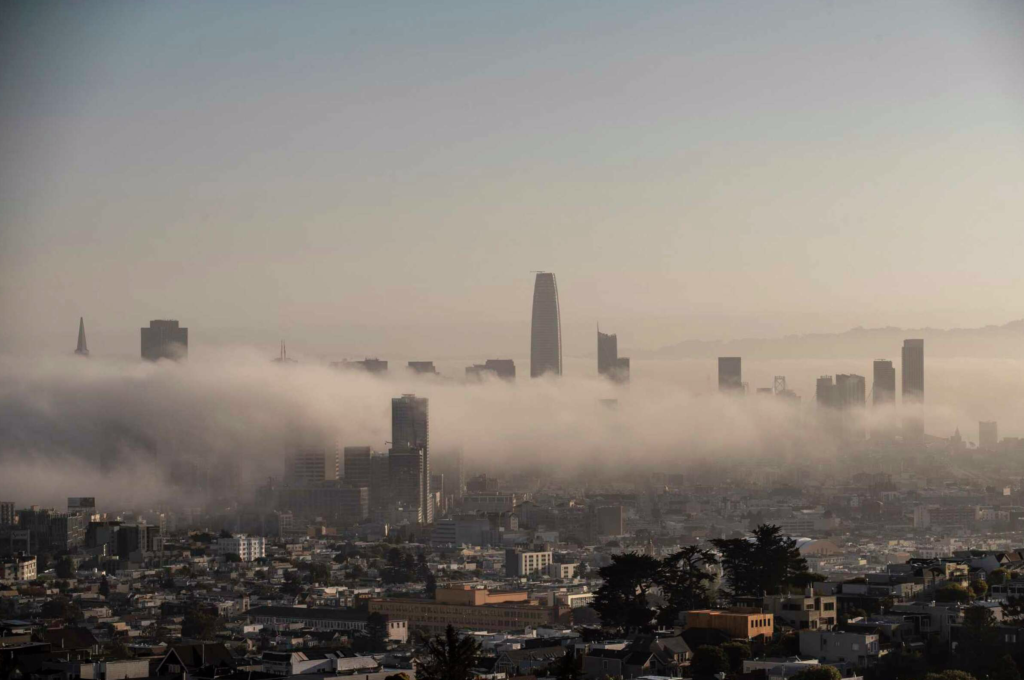
Downtown San Francisco is failing. Of that, there’s little question. Our recovery from the COVID economic downturn is dead last in the nation,according to a recent study from the Urban Displacement Project.
That’s no surprise; our financial district is a relic from the urban renewal school of planning — a way to capture value from commuters who fled the city for the suburbs. One need only look at downtown’s streets — replete with dangerous one-way thoroughfares, designed to speed drivers to and from offices — to see it isn’t designed for the people who live here. It’s a daytime repository for outsiders and their cash.
Downtown’s design was effective in that it turned the neighborhood into the overwhelming engine for the city’s tax base. But those days appear to be waning as remote work has gained an unyielding foothold and companies are shedding their office space accordingly. For downtown San Francisco to survive, and for the city to maintain its generous tax base, it will take expansive reinvention.
Thankfully, there are models for such a transformation.
After the attacks of 9/11 devastated lower Manhattan, New York’s financial district found itself in a similar position as San Francisco. Office workers, it was assumed, would never want to work in high rises again due to fears of terrorism. So, what would become of a neighborhood of pits and ruins that was otherwise almost exclusively comprised of banking, real estate and insurance companies?
Rather than bring the neighborhood back to its old self — a commuter hub by day and a ghost town after dark — New York came up with a vision for reinvention. The financial district would become a place where people actually lived as well as worked. Local, state and federal officials rallied behind the plan, providing funding to retrofit the area’s overabundance of office space.
The result? Lower Manhattan didn’t just bounce back, it became New York’s fastest growing neighborhood — adding over 60,000 residents and going from a daytime waylay station for finance bros to a 24-hour district filled with life.
San Francisco, it’s true, isn’t New York; the quirks that make us unique also make us difficult.
In lower Manhattan, older buildings were largely the ones chosen for a retrofit because they were the easiest and least expensive to redesign and make code compliant with residential dwelling. But San Francisco planning experts say that isn’t likely to happen here; this city puts a premium on vintage. Instead, ugly 1980’s office towers are most likely to sit vacant — and therefore may be the most financially feasible to retrofit, even if they pose significant design challenges.
In a city that can’t seem to agree on anything, it’s hard to find a San Franciscan who would argue that such buildings wouldn’t be better served with people living in them. But any concerted effort to reimagine downtown beyond an odd project or two will require a comprehensive vision like New York’s — one that will almost certainly have to include generous government subsidies.
At the moment, that seems highly unlikely.
California housing officials are investigating San Francisco for its byzantine and likely illegal approach to residential planning. Why on Earth would California commit to providing office conversion funding when our municipal planning entities seem to delay and/or raise the cost for new housing at every impasse?
Enter AB 2011 from state Assembly Member Buffy Wicks, D-Oakland
Wicks’ bill would streamline the approval process to allow developers to turn office buildings, parking lots or commercial strips into 100% affordable or mixed-income housing by-right — so long as they pay construction laborers union-level wages and provide health care to anyone working on a building with 50 or more units. This red tape-cutting would allow retrofit projects to circumvent frivolous California Environmental Quality Act lawsuits that spell delay or doom in San Francisco — like the infamous effort to turn a valet parking lot at 469 Stevenson St. into 495 units of mixed-income housing.
AB 2011 isn’t magic. San Francisco won’t see its empty office towers turned into housing overnight should it pass. But there could be other immediate impacts. San Francisco’s Financial District has an overwhelming amount of land devoted to parking. With fewer commuters, AB 2011 could help us use that space to house people, not cars.
Mostly though, the bill would be a conversation starter for San Francisco.
Transforming downtown in a meaningful way looks financially and politically hopeless right now. But that could change if developers know their projects won’t get stuck for years in our tortuous approval process. Should such interest arise, state officials could then decide that financial subsidies to our city aren’t the lost cause they are now.
New York’s example shows that downtown transformation is possible. But not without state help and collaboration. AB 2011 could be the push San Francisco needs to jump-start that collaborative new vision — and to escape the bureaucratic paralysis that continues to undermine even our most fledgling moves toward progress.